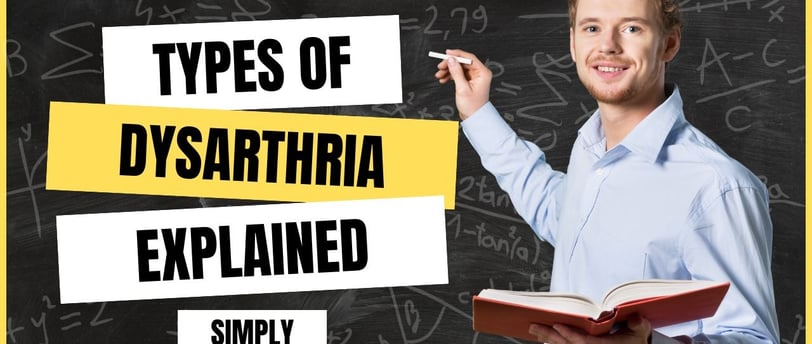Online Speech Therapy Platform
Types of Dysarthria
Learn about the different types of dysarthria, including spastic, flaccid, and ataxic. Discover how each type affects speech and how therapy can help manage symptoms.
DYSARTHRIA
7/12/20252 min read


What Is Dysarthria?
Dysarthria is a motor speech disorder that happens when the muscles used for speaking are weak or hard to control. This can lead to slurred, slow, or unclear speech. It’s usually caused by neurological conditions such as stroke, brain injury, Parkinson’s disease, ALS, or cerebral palsy.
But did you know that there are different types of dysarthria, each with unique symptoms? Let’s break them down in a simple and easy-to-understand way.
1. Spastic Dysarthria
Cause: Damage to the upper motor neurons (brain pathways that help control movement).
Symptoms:
Stiff, tight muscles
Slow and effortful speech
Harsh or strained voice
Low pitch
Example: Often seen after a stroke or in conditions like cerebral palsy.
2. Flaccid Dysarthria
Cause: Damage to the lower motor neurons (nerves that directly connect to the muscles).
Symptoms:
Weak, soft muscle tone
Nasal-sounding speech
Breathy voice
Drooping of facial muscles
Example: Common in conditions like Bell’s palsy or muscular dystrophy.
3. Ataxic Dysarthria
Cause: Damage to the cerebellum (area of the brain that controls coordination).
Symptoms:
Jerky, uncoordinated speech
Irregular rhythm and pitch
Slurred or “drunken” speech
Example: Often seen in cerebellar strokes or multiple sclerosis (MS).
4. Hypokinetic Dysarthria
Cause: Often linked to basal ganglia damage, commonly in Parkinson’s disease.
Symptoms:
Low volume
Monotone voice
Short rushes of speech
Reduced facial expression
Example: Parkinson’s patients may struggle to project their voice clearly.
5. Hyperkinetic Dysarthria
Cause: Involuntary movements affecting speech muscles (linked to basal ganglia).
Symptoms:
Sudden voice changes
Irregular speech patterns
Harsh or strained voice
Example: Seen in Huntington’s disease or Tourette’s syndrome.
6. Mixed Dysarthria
Cause: Combination of two or more types of dysarthria due to widespread brain damage.
Symptoms:
Vary depending on the types involved.
Example: ALS patients may show both spastic and flaccid features.
Why Identifying the Type Matters
Understanding the specific type of dysarthria is crucial for personalized therapy. Speech-language pathologists (SLPs) design different treatment plans depending on:
The muscles affected
The person’s communication needs
The severity of the condition
How Therapy Can Help
At TelloMeet, we offer personalized online speech therapy designed to address each type of dysarthria. Whether you’re recovering from a stroke or managing a chronic condition like Parkinson’s, our therapists can help improve:
Speech clarity
Breath control
Muscle coordination
Confidence in communication
Final Thoughts
Every type of dysarthria presents differently, but with the right support and consistent therapy, speech and quality of life can significantly improve. Early diagnosis and professional intervention are key.
🔗 Book a free consultation with a speech-language pathologist today on TelloMeet!
